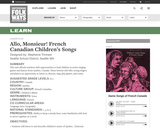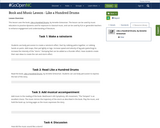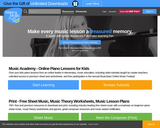
Students will be able to effectively recognize and imitate AB binary form through movement.
- Subject:
- Arts Education
- Music
- Material Type:
- Lesson Plan
- Provider:
- Teachers.Net
- Author:
- Meghan Webb
- Date Added:
- 02/26/2019

Students will be able to effectively recognize and imitate AB binary form through movement.

Students will discover the differences in musical tempo between fast and slow. Students will learn to use the
correct musical terms to describe the tempo of each piece. Students will use streamers and their bodies to
show at what tempo each piece is played.

Students will discover how to read music notes in the treble clef and then will learn to perform simple songs on
xylophones, through reading the story Freddy the Frog and the Thump in the Night by Sharon Burch.

This unit affords teachers with opportunities to lead children in active singing games and
dances from Quebec, Canada. These lessons will offer young singers and players an
opportunity to listen to, discuss, sing, play games, and create.

Students are led in active singing games and dances from Quebec, Canada. These lessons will offer young singers and players an
opportunity to listen to, discuss, sing, play games, and create.

Students will learn about dynamics, tempo, acoustics and instruments in the music of Charles Ives. Students will be introduced to and learn about the literary term onomatopoeia, and how they can relate it to the sounds of Ives' music. Making the connection between literacy and music, students will create their own musical onomatopoeias using various media, such as water color, tempera paint, crayons, magazine text and markers.

This lesson uses the book, Like a Hundred Drums, by Annette Griessman. The lesson can be used by music educators to practice dynamics and for exposure to classical music, and can be used by ELA or generalist teachers to enhance engagement and understanding of literature.

Students will explore creating moods with music. Students will assimilate this new knowledge through the analysis of a story and the creation of a musical composition that reflects and enhances it. This activity will culminate with the recording of their musical accompaniment and story to produce a book on tape.

This lesson is designed to teach positional, directional and spatial skills, social skills, large motor skills, creative skills, and oral vocabulary using the "Aquarium" movement from Carnival of the Animals by Camille Saint- Saëns. The lesson is designed specifically to teach early childhood developmentally delayed students but can the challenge can easily be increased to make it appropriate for older grades or ELL classes.

This lesson introduces basic communication skills by asking the following questions: "What does communication mean? What do good communicators do? Selections from Fanfare for the Common Man Fanfare for the Common Man by Aaron Copland and Carnival of the Animals by Camille Saint-Saëns will help us define musical terms and discover the answers to our questions.

Students will be able to relate the similarities and differences experienced by orchestra members and students of a first grade class as connected to the idea of the interdependence within a community. They will recognize that as members of a classroom community there are expectations for jobs, behavior, and intrinsic motivation to function to the best of the individual's ability. They will understand that a community within an orchestra has a similar construct to a classroom in that it is led by a conductor and that each person plays an important role within the playing of a piece, practicing their individual part, and colleague support.

Students will be introduced to the great jazz composer and band leader, Duke Ellington by listening to his re-composed and re-orchestrated version of Nutcracker Suite by Pyotr Tchaikovsky. Students will be passively introduced to the music of Duke Ellington with the goal that students recognize similar melodies in his work to those of Tchaikovsky. Students will learn about jazz instruments and connections will be made to literature, social studies, music and writing.

Students will larn about a time in the past when three famous people- Igor Stravinsky, George Balanchine and John Ringling, Jr. - joined forces to create a ballet for ballerinas the size of battleships. Students will listen and move to Stravinsky's Circus Polka: For a Young Elephant, written for the ballet that featured fifty ballet dancers and fifty elephants. Students will hear the story, Ballet of the Elephants, and learn about the men who worked together to make it happen.

Students will learn to focus and listen to music and begin to recognize the musical elements of dynamics and tempo. Students will learn to discuss the emotions that music can portray and evoke with a writing activity to allow students to brainstorm ideas of what they hear.

Students learn eight basic locomotor skills of walking, running, jumping, hopping, skipping, galloping, side sliding and leaping. The teacher teaches the difference between fast, medium, and slow movements while introducing the musical vocabulary for tempo: fast/presto, medium/moderato and slow/adagio. The students listen to the beat of a percussion instrument and determine if they should move fast, medium, or slow to match the tempo of the beat.

In this lesson plan, students will become familiar with the music of Rimsky-Korsakov in fullfillment of the National Standards for Music (listening to, analyzing, and describing music).

While studying ecosystems, students will focus on the changes that occur in deciduous forest throughout the seasons. With that knowledge, they will listen to and analyze Vivaldi's The Four Seasons. As a culminating activity, students will use oil pastels to show what a deciduous forest would look like during each season.

The student will have a an understanding of (1) the difference in day and night, (2) what causes day and night, (3) what does day and night look like, (4) what activities are most often related to each of these times, and (5) what kind of animals are awake and asleep in the day or night. The student will be able to express these activities in dance and to decide which music best fits daytime and nighttime. The student will also be able to visually depict the different times of the 24-hour day in dramatic play and on paper.

Students will gain an understanding of the difference in day and night, what causes day and night, what does da and night look like, what activities are most often related to each of these times, and what kind of animals are awake and asleep in the day or night. This integrated lesson uses the first movement, Morning Mood, from Edvard Grieg's Peer Gynt Suite No. 1, Op. 46 and Frederick Chopin's Nocturne Op. 9, No. 2, to study day and night by associating musical selections that depict aspects of each time.

In this three lesson unit, the concept areas of rhythm, melody, harmony, form and tone color are used. Skills will be developed in singing, moving, listening, playing instruments, creating, analyzing, and relating music to other areas such as history and literature.